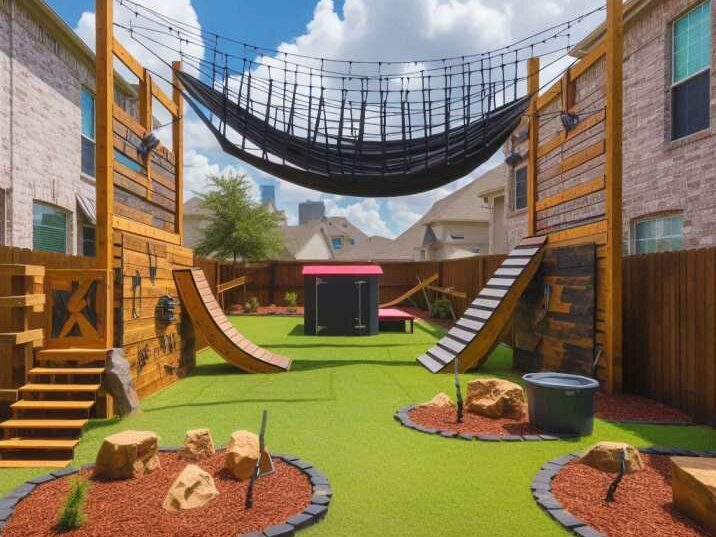Table of Contents:
Table of Contents
- Understanding the Backyard Ninja Warrior Obstacle Course
- Selecting the Right Location and Space
- Essential Equipment and Materials
- Designing Your Course
- Construction and Installation Process
- Maintenance and Upkeep
- Safety Guidelines and Precautions
- Conslusion
- Frequently Asked Questions (FAQs)
Introduction
The backyard ninja warrior obstacle course has gained significant popularity in recent years. It offers individuals of all ages the opportunity to test their physical and mental strength against challenging obstacles. Building your own backyard ninja course allows for year-round outdoor fun and fitness. In this article, we will explore the history and popularity of ninja warrior training, the benefits of a backyard obstacle course, selecting the right location and space, essential equipment and materials, designing the course, the construction and installation process, maintenance and upkeep, safety guidelines and precautions, and frequently asked questions.

The History and Popularity of Ninja Warrior Obstacle Courses
Ninja warrior obstacle courses have become increasingly popular in recent years. The thrill of testing your physical and mental strength against challenging obstacles has captivated people of all ages
While these courses are commonly found in gyms or at special events, building your own backyard ninja course allows for year-round outdoor fun and fitness.
Benefits of a Backyard Obstacle Course
A backyard obstacle course offers numerous benefits. It provides a convenient and accessible way to engage in physical activity and improve overall fitness. It allows individuals to challenge themselves and improve their strength, agility, and endurance. Additionally, a backyard obstacle course can be a fun and engaging activity for the whole family, promoting bonding and healthy competition
Selecting the Right Location and Space
When selecting the location for your backyard obstacle course, there are several factors to consider. First, assess your backyard space to determine the available area for the course
Most backyard courses take up at least 8 x 10 x 12 feet, but the space you have may vary. Consider the layout and flow of your backyard and choose a location that allows for optimal use of the available space
It is important to ensure that the location provides enough room for participants to navigate the obstacles safely.
Factors to Consider when Choosing the Location
When choosing the location for your backyard obstacle course, consider the following factors:
- Accessibility: Ensure that the location is easily accessible for participants.
- Safety: Choose a location that is free from hazards and provides a safe environment for participants.
- Visibility: Select a location that allows for easy supervision of participants.
- Terrain: Consider the terrain of your backyard and choose a location that is suitable for building and navigating the obstacles.
Optimizing the Available Space
To optimize the available space in your backyard, consider the layout and flow of the obstacle course. Plan the placement of obstacles strategically to maximize the use of space and create a challenging and engaging course
Incorporate different types of obstacles that can be arranged efficiently within the available area. This will ensure that participants have a varied and exciting experience while navigating the course.
3: Essential Equipment and Materials
To build a backyard ninja warrior obstacle course, you will need several essential equipment and materials. These include sturdy beams and ropes for constructing obstacles and providing support, as well as grip-enhancing accessories to improve participants’ grip strength. Sturdy beams and ropes are the backbone of your obstacle course, providing the necessary structure and stability for various obstacles. It is important to choose high-quality materials that can withstand the weight and movement of participants. Grip-enhancing accessories, such as chalk or grip gloves, can help participants maintain a secure grip on the obstacles, reducing the risk of slipping or falling.
Finding reliable suppliers for these materials is crucial to ensure the quality and durability of your obstacle course. Look for suppliers that specialize in providing equipment for ninja warrior training or outdoor adventure courses. Consider factors such as product reviews, customer feedback, and the supplier’s reputation in the industry. It is also helpful to compare prices and inquire about warranties or guarantees offered by the suppliers.
Section 4: Designing Your Course: Tips and Tricks
Designing your backyard obstacle course requires careful planning and consideration. Start by planning the layout and flow of the course. Consider the available space and the desired level of difficulty. Take into account the different skill levels of participants and ensure that the course offers a range of challenges to accommodate everyone. It is important to strike a balance between difficulty and safety.Incorporate different types of obstacles to provide a varied and challenging experience. Some popular obstacles include the salmon ladder, rope junction, rumbling dice, devil steps, globe grasps, pipe grasps, cargo net, cliff hanger, peg board, and jumping bars.
These obstacles can test participants’ upper body strength, agility, balance, and coordination.When designing your course, prioritize safety considerations. Ensure that the obstacles are properly secured and stable. Minimize the risk of injuries by providing sufficient padding or landing surfaces around high-risk areas. Consider the space between obstacles to allow participants to move safely from one obstacle to another.
Section 5: Construction and Installation Process
The construction and installation process of a backyard obstacle course involves several steps. Begin by building a solid foundation for the course. This may involve leveling the ground or adding support structures to ensure stability. Use appropriate tools and techniques to secure the beams and ropes in place, ensuring that they can withstand the weight and movement of participants.Assemble the obstacles according to the design and connect them to create the course. Follow the manufacturer’s instructions or consult professional advice if needed. Double-check that all the components are securely fastened and that there are no sharp edges or protruding parts that could cause injuries.
Once the course is built, it is important to test it for safety. Walk through the course yourself or have someone else try it out to identify any potential hazards or issues. Make any necessary adjustments or reinforcements to ensure the safety of participants. Regularly inspect the course for wear and tear, and address any maintenance needs promptly.
Section 6: Maintenance and Upkeep
Regular maintenance and upkeep are essential to ensure the longevity and safety of your backyard obstacle course. Conduct regular inspections to identify any potential issues or damage. Check the stability of the beams and ropes, as well as the condition of the obstacles. Look for signs of wear, such as frayed ropes or loose bolts, and address them promptly.Implement cleaning techniques to keep the course clean and free from debris. Sweep or hose down the course regularly to remove dirt, leaves, or other materials that can accumulate and create hazards.
Use a mild detergent or cleaning solution to remove any stains or marks on the obstacles. Avoid using harsh chemicals that could damage the materials.Familiarize yourself with common issues that may arise and troubleshoot them accordingly. For example, if the ropes become too slippery, consider applying grip-enhancing chalk or replacing the ropes with ones that provide better grip. If the beams start to sag or show signs of weakness, reinforce them or replace them if necessary. Address any issues promptly to ensure the safety and functionality of the course.
Section 7: Safety Guidelines and Precautions
Safety should be a top priority when using a backyard obstacle course. Implement proper warm-up exercises before participating in the course to prevent injuries. Warm-up exercises should include stretching, light cardio, and mobility exercises to prepare the body for physical activity.Implement injury prevention strategies during the course. Encourage participants to use proper technique and form when navigating the obstacles. Emphasize the importance of maintaining an appropriate level of challenge without pushing beyond their capabilities.
Provide guidance and supervision, especially for younger participants or those who are new to the course.Have emergency preparedness measures in place to ensure the safety of participants in case of accidents or injuries. Make sure there is a first aid kit readily available and that someone present is knowledgeable in basic first aid. Familiarize yourself with local emergency numbers and consider having a phone nearby in case of emergencies.
Conclusion
Building a backyard ninja warrior obstacle course offers a fun and challenging outdoor activity for all ages. By selecting the right location, using quality equipment, and designing a safe course, you can create an engaging experience. Regular maintenance, safety precautions, and emergency preparedness are essential. Enjoy the benefits of increased fitness, improved strength, and family bonding with your very own backyard obstacle course.
8: Frequently Asked Questions (FAQs)
- How much space is required for a backyard ninja warrior obstacle course?
- Most backyard courses take up at least 8 x 10 x 12 feet, but the space you have may vary.
- What are some popular obstacles to include in the course?
- Popular obstacles to include in a backyard ninja warrior obstacle course can vary, but some examples include the salmon ladder, rope junction, rumbling dice, devil steps, globe grasps, pipe grasps, cargo net, cliff hanger, peg board, and jumping bars.
- Can children participate in the course?
- Yes, children can participate in a backyard ninja warrior obstacle course. However, it is important to ensure that the course is age-appropriate and that proper safety measures are in place.
- How can I ensure the safety of participants?
- To ensure the safety of participants, it is important to follow safety guidelines and precautions, such as implementing proper warm-up exercises, injury prevention strategies, and emergency preparedness measures.
- Are there any professional training programs available?
- Yes, there are professional training programs available for ninja warrior training. These programs are typically offered at specialized gyms or training facilities.


